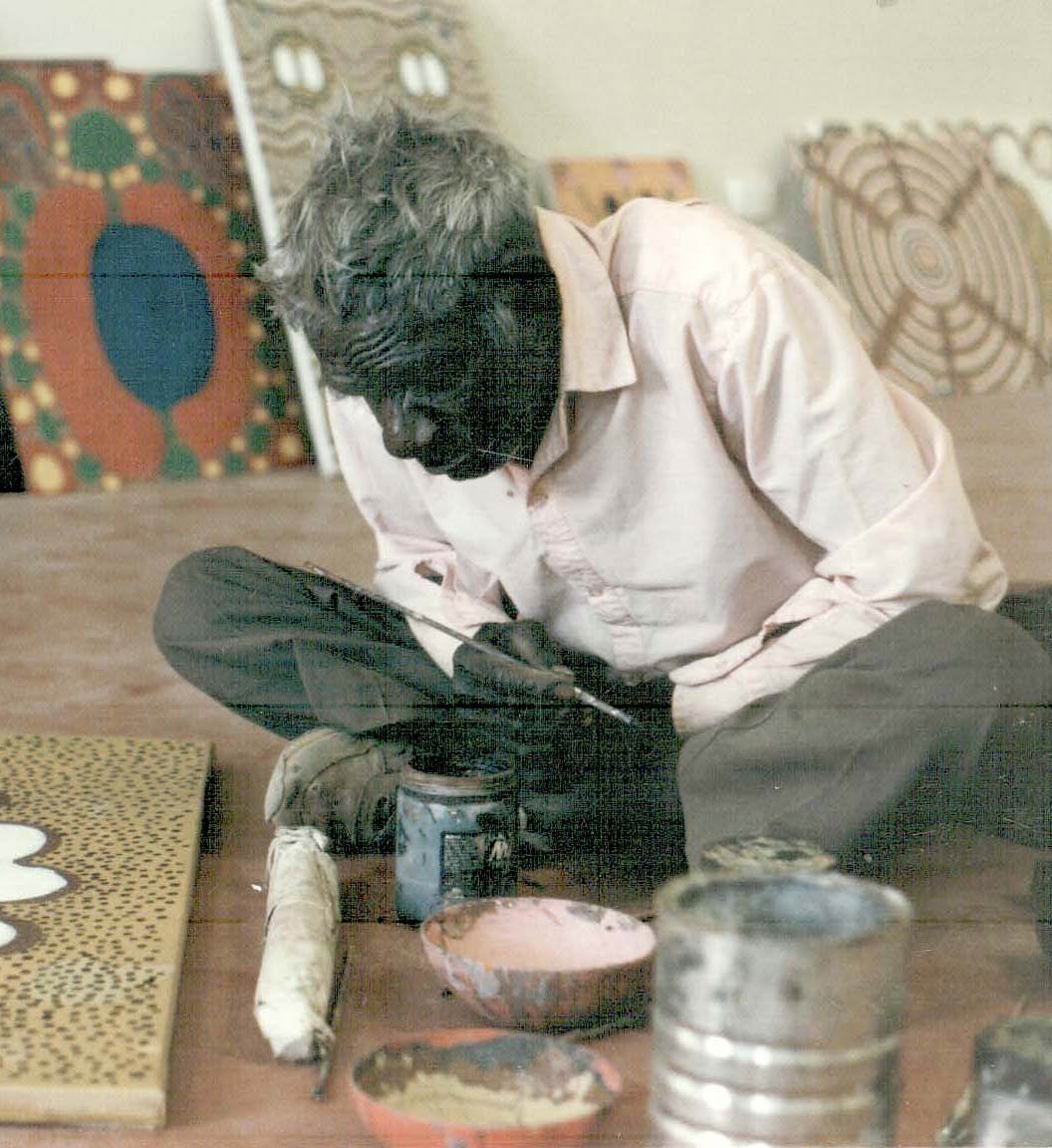JARINYANU DAVID DOWNS
BIOGRAPHY

Photo: National Museum of Australia
Jarinyanu David Downs was one of those old cowboys who, like Rover Thomas, was born in the Great Sandy Desert in the 1920’s and eventually, toward the end of their lives, settled in the Kimberley region in the North West of Australia. He first moved from his traditional lands to the cattle stations in the 1940s, while still in his early twenties, to join the family of his promised bride. The next twenty years were spent droving cattle as well as occasionally working in the gold mines around Halls Creek. Jarinyanu’s first European boss bequeathed him his European name, David Downs, however when he eventually settled in Fitzroy Crossing, due to its proximity to the Wangkajunga country of his birth, he reverted to using his own real name.
He first began working as an artist after moving to Fitzroy Crossing in the 1960s, decorating boomerangs, shields and coolamons. However it wasn’t until 1980 that he was commissioned to work on paper and canvass, using traditional ochres with natural resins as a binder. These initial works were typically dramatic dark silhouettes against a white acrylic background. Pictorial symbols were used to represent country, and though figures appear, they were merely one element within a larger composition, in contrast to the dominance of the figure in his later paintings. The influence of Christianity could be seen from the outset in many of his earliest works. The United Aboriginal Mission established in the 1950s at Fitzroy Crossing was a powerful presence in the community. As Jarinyanu’s career developed he developed a visual language that expressed his Christian beliefs coupled with a celebration of traditional law. He believed that as god created the natural world, it was perfectly acceptable to pay homage to his creation of the surrounding environment, in accordance with its local cultural form. In doing so he created a relationship between Australian Christianity and specific cultural sites, which white Australia had neglected to identify. At the same time, he daringly depicted ancestral beings in human form, visualizing the once unseen Ngarrangkani (Dreaming) ancestors.
The primary vehicle for expressing this two-way religious philosophy was the song cycle of Kurtal, the ancestral rain man. He was born on a distant island and traveled to the Kimberley as a cyclone. As he moved on inland he created places of ‘living water’ (permanent water sources) and visited other rain men, occasionally gaining valuable items from them through trickery and magic. The figure of Kurtal, often depicted with ceremonial headdress, and the participants in ceremonies relating to his story, appear constantly in Jarinyanu’s work. Other than his occasional canvases depicting Christian themes such as Whale Fish Vomiting Jonah 1993 and Jesus Preach’im All People 1986, it is the Kurtal figure that filled canvas after canvas until his death in 1995. Jarinyanu’s success at bridging two such separate cosmologies can be seen as part of a broader tradition of cultural exchange in the Kimberley, predating European contact. However, it is a sign of great triumph that Downs’s contact with Christianity did not weaken his commitment to ritual law. He was very conscious of himself as an artist. ‘I’m different’ he would claim, when describing himself (Kentish 1995: 2). His peers would describe his directness by exclaiming ‘he’ll tell you right out’ (Kentish 1995: 2)
He had come to terms with the concept of individual fame brought keenly into focus by viewing his own work in art galleries, and the experience of having his portrait painted and hung in the Archibald Prize (Kentish 1995: 2). His ability to negotiate his way in the white world no doubt had great influence on his success. He was one of three Walmajarri artists at Fitzroy crossing that began painting on canvass through private representation as individual artists. Jarinyanu along with Peter Skipper Jangkarti were represented by Duncan Kentish, whilst Jimmy Pike’s whose career began in Fremantle prison in 1980 was represented by Steve Culley and David Wroth of Desert Designs. Individual representation brought many rewards, particularly solo exhibitions in galleries such as Bonython-Meadmore Gallery in 1988, Roar 2 Studios in 1991, Chapman Gallery in 1993, and Ray Hughes in Sydney in 1995, where always resplendent in his white shirt and pants, he was presented as a contemporary artist, alongside non-indigenous artists.
Jarinyanu David Downs enjoyed a highly successful career encompassing sculptural artifacts, painting and a significant body of limited edition prints. He was one of the earliest Aboriginal artists to be individually represented and, at the time of his death, was considered one of the leading lights of the contemporary Aboriginal art movement.
© Adrian Newstead
References
Kentish, Duncan, October 1995, ‘’Jesus Country, in Mount Gambier: The Southern Explorations of David Downs,’ Duncan Kentish Fine Art, Adelaide.
Ryan, J., 1993, Images of Power, Aboriginal Art of the Kimberley, exhib, cat., National Gallery of Victoria, Melbourne

